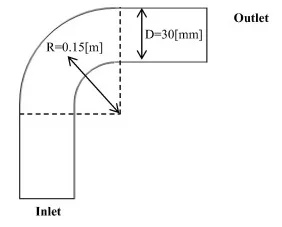Use our pressure drop in elbow calculator to determine your loss in a 90° pipe bend!
Pressure Drop in Elbow Calculator
K =
Pressure Drop (∆P) [Pa] =
Table of Contents
Introduction
Figuring out how much pressure is lost as fluid moves through pipes can be tricky, especially when the pipes have different shapes and equipment. In this article, we’ll talk about how to calculate the pressure drop using empirical head loss factor formula when fluid flows around 90° pipe elbow. First, we will briefly talk about the importance of pressure drop and its negative consequences. Then, we’ll mention the formula used and how to derive the head loss coefficient through empirical studies. At the end, you will also find a source to calculate the pressure drop in different geometries and shapes.
Why It Matters to Calculate Pressure Drop in Pipes?
In hydraulics, pressure drop occurs due to the resistance encountered by a fluid as it flows through a pipe with bends or elbows. The possible outcomes of pressure drop are:
- Increased energy consumption: In pipelines where the pressure drop is not minimized, the pumps have to spend extra energy to maintain the fluid flow rate.
- Decreased system efficiency: Incorrect calculation of the pressure drop in the pipeline during the design process and resulting deviations in expected pressure levels affect the flow rate and may interrupt the fluid transport processes.
- Increasing operating costs: The excess energy need turns into higher operating costs.
Empirical Formula for Pressure Drop in Pipe Elbows
The pressure drop ∆P across a 90° elbow can be calculated using the following empirical formula:
Where K is the head loss coefficient and is the fluid density. The term V represents the fluid velocity, which can be related to the volumetric flow rate Q and pipe diameter D as:
How to Calculate Head Loss Coefficient?
The loss coefficient K is an empirical parameter that can be expressed as:
Here a, b, and c are empirical values determined through experimental measurements and r is the turning radius of the elbow, and D is the diameter of the pipe. In the image below, you can find a representation of the elbow radius and pipe diameter to use in the pressure drop in elbow calculator:

As the experiments indicate, the parameters for standard radius elbows are:
a = 0.6 – 1
b = 0.2 – 0.5
c ≈ 1
Then, the parameters for long-radius elbows are:
a ≈ 0.2
b = 0.1 – 0.3
c ≈ 1
It should be noted that these empirical constants can vary according to many different conditions such as Reynolds number, roughness, etc. It is recommended to refer to specific experimental data for precise calculations. You can find a table here for other specific geometries and shapes.
Conclusion
Understanding and calculating the pressure drop in pipe bends is crucial for efficient hydraulics lines and cost-effective system operation. The presented empirical formula for the loss coefficient provides a method to approximate these pressure drops in various industrial environments.
Experimental data in scientific articles and computational fluid dynamics models are recommended for more accurate and case-specific results.

